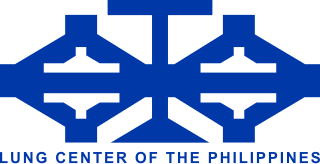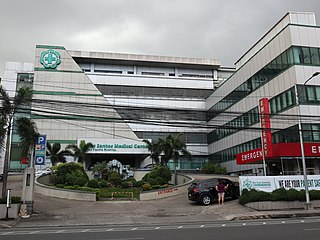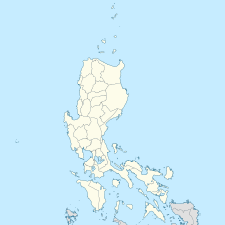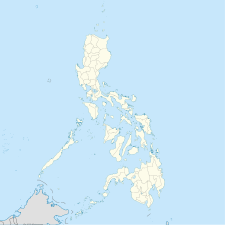
Metropolitan Manila, commonly shortened to Metro Manila and formally the National Capital Region, is the capital region and largest metropolitan area of the Philippines. Located on the eastern shore of Manila Bay, the region lies between the Central Luzon and Calabarzon regions. Encompassing an area of 619.57 km2 (239.22 sq mi) and with a population of 13,484,462 as of 2020, it is composed of sixteen highly urbanized cities: the capital city, Manila, Caloocan, Las Piñas, Makati, Malabon, Mandaluyong, Marikina, Muntinlupa, Navotas, Parañaque, Pasay, Pasig, Quezon City, San Juan, Taguig, and Valenzuela, along with one independent municipality, Pateros. As the second most populous and the most densely populated region in the Philippines, it ranks as the 9th most populous metropolitan area in Asia and the 6th most populous urban area in the world.

Quezon City, also known as the City of Quezon and Q.C., is the most populous city in the Philippines. According to the 2020 census, it has a population of 2,960,048 people. It was founded on October 12, 1939, and was named after Manuel L. Quezon, the second president of the Philippines.

Ortigas Center is a central business district located within the joint boundaries of Pasig, Mandaluyong and Quezon City, within the Metro Manila region in the Philippines. With an area of more than 100 hectares, it is Metro Manila's second most important business district after the (Makati CBD). It is governed by Ortigas Center Association, Inc.

Santa Cruz, officially the Municipality of Santa Cruz, is a 1st class municipality and capital of the province of Laguna, Philippines. According to the 2020 census, it has a population of 123,574 people.

Trinity University of Asia, also known as TUA or simply Trinity, is a non-sectarian private university located in Quezon City, Philippines. It was named after Trinity College (Connecticut) whose president then was the founder's father. Formally established in 1963 as an elementary, high school and collegiate educational institution by the Protestant Episcopalians, it dates back its earliest establishment in 1907 when the Trinity University of Asia - St. Luke's College of Nursing, its oldest organic academic unit, was established under the St. Luke's Hospital, the present day St. Luke's Medical Center. It later acquired its university status on July 18, 2006.

The Lung Center of the Philippines (LCP) is a government tertiary hospital specializing in the cure and prevention of lung and other chest diseases, located on Central, Quezon City, Philippines. The center receives budgetary support for its operations from the national government. It was constructed on public land donated by the National Housing Authority.

St. Luke's Medical Center (SLMC) is a private non-profit health care institution based in Quezon City, Metro Manila, Philippines which operates two hospitals of the same name in Quezon City and Taguig.

NYU Langone Health is an academic medical center located in New York City, New York, United States. The organization consists of the NYU Grossman School of Medicine and NYU Grossman Long Island School of Medicine, both part of New York University (NYU), and more than 300 locations throughout the New York metropolitan area, including six inpatient facilities: Tisch Hospital; Kimmel Pavilion; NYU Langone Orthopedic Hospital; Hassenfeld Children's Hospital; NYU Langone Hospital – Brooklyn; and NYU Langone Hospital – Long Island. It is also home to Rusk Rehabilitation. NYU Langone Health is one of the largest healthcare systems in the Northeast, with more than 46,000 employees.

The Southern Philippines Medical Center (SPMC) is a government hospital under the Department of Health of the Republic of the Philippines. It is located at the JP Laurel Ave, Bajada, Davao City. It began as the Davao Medical Center. Its name was changed on November 19, 2009, by Republic Act 9792.

Metro Pacific Investments Corporation (MPIC) is a Philippine-based unit investment holding company of First Pacific Company Limited through Metro Pacific Holdings, Inc. MPIC through its subsidiaries, provides water, sanitation, and sewerage services and also operates in real estate, and infrastructure projects. It also invests in some hospitals in the Philippines.

The National Kidney and Transplant Institute is a tertiary referral hospital located in Central, Quezon City, Philippines. The hospital opened on January 16, 1981.

Manuel L. Quezon Avenue, more often called as Quezon Avenue, or simply Quezon Ave, is a 6.1-kilometer (3.8 mi) major thoroughfare in Metro Manila named after President Manuel Luis Quezon, the second president of the Philippines. The avenue starts at the Quezon Memorial Circle and runs through to the Welcome Rotonda near the boundary of Quezon City and Manila.

The Elliptical Road is a 1.98-kilometer (1.23 mi) roundabout in Quezon City which circumscribes the Quezon Memorial Circle, a large park. It was named after its elliptical shape. The spinning in this roundabout is in a counterclockwise direction. The road is divided into 8 lanes, wherein 3 are the main lanes, 4 lanes are for exiting vehicles with one lane for bicycles and pedicabs.

De Los Santos Medical Center is a 150-bed private tertiary hospital in Quezon City, Philippines managed by Metro Pacific.

St. Luke's Medical Center – Global City is a hospital at the Bonifacio Global City in Taguig, Metro Manila, Philippines. It is the sister facility of the hospital of the same name in Quezon City. Both are affiliated with the Episcopal Church of the Philippines.

St. Luke's Medical Center – Quezon City is a hospital in Quezon City, Metro Manila, Philippines. Forming as a part of St. Luke's Medical Center group of hospitals, it was founded in 1903 by the American missionary Charles Henry Brent under the Protestant Episcopal Church in the United States of America (PECUSA) as the third oldest American and Protestant hospital in the Philippines after CPU–Iloilo Mission Hospital and Silliman University Medical Center.

The East Avenue Medical Center (EAMC) is a government-owned tertiary general hospital located in Central, Quezon City, Philippines.

East Avenue is a major street located within the Diliman area of Quezon City, Philippines. It runs north–south through the eastern edge of Triangle Park. The street is located in Quezon City's government area, known for different national and local government institutions, offices, and hospitals. It is also home to the Quezon City Hall Complex located on the avenue's junction with Elliptical Road. The entire avenue is designated as National Route 174 (N174) of the Philippine highway network.

The Philippine Children's Medical Center is a government-run children's hospital in Quezon City, Metro Manila, Philippines. The hospital as a government-owned and controlled corporation is attached to the Department of Health.


























